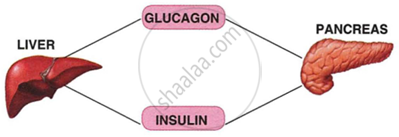Advertisements
Advertisements
प्रश्न
Write the role of oestrogen in ovulation?
उत्तर
Oestrogen is the ovarian hormone secreted during the proliferation phase of menstrual cycle from the 6th day to 14th day of the cycle. On 14th day of the cycle, under the influence of uteinizing hormone, ovum is released from the griffin follicles. This process is known as ovulation.
संबंधित प्रश्न
Define Endocrine gland
Give an example of hypercalcemic hormone.
add a note on deficiency of thyroxine.
What is the difference between an exocrine gland and an endocrine gland?
Fill in the blank:
Hormones are produced by ____________.
Exophthalmic goitre is caused due to the overactivity of ______.
Mention any two differences between a hormone and an enzyme.
Mention three important differences between the action of hormones and that of nerves in the regulatory mechanism of our body.
Identify the ODD term in each set and name the CATEGORY to which the remaining three belong :
Example : glucose, starch, cellulose, calcium
Odd term : calcium
Category : others are different types of carbohydrates
Addison’s disease, Cushing’s Syndrome, Acromegaly, Leukemia
Name the following:
The largest endocrine gland
Which one of the following statement is true/ false?
Islets of Langerhans are found in the brain.
Which one of the following statement is true/ false?
The pituitary gland is both exocrine and endocrine in function.
Name the hormone responsible for the following function:
Increased reabsorption of water in the kidneys
Is the following gland an exocrine or an endocrine gland?
Liver
Complete the following:
| Gland/Organ | Hormone | Function |
| (i) Stomach | __________ | __________ |
| (ii) Parathyroid | __________ | __________ |
| (iii) __________ | __________ | Lowers blood sugar level. |
| (iv) Adrenal medulla | __________ | __________ |
| (v) Pancreas (Alpha cells) | __________ | __________ |
| (vi) Testes | __________ | __________ |
Organs like the stomach and intestine are also endocrine glands. Why?
Differentiate: Insulin and Glucagon.
Name the Following: Hormone secreted by corpus luteum.
Give the Technical Term: Name two hormones secreted by the alimentary canal.
Fill in the Blanks:
______ is called father of endocrinology.
Fill in the Blanks:
The glands with ducts are called ______.
Place the words at the bottom of the page next to the number that shows the location of the Endocrine Glands.

(1) ________
(2) ________
(3) ________
(4) ________
(5) ________
(6) ________
(7) ________
(8) ________
(9) ________
Pancreas Hypothalamus Pituitary Parathyroid Ovaries Adrenal Thyroid Thymus Testes
Some of the endocrine glands are shown by the guidelines.

(i) Name the glands 1 to 5.
(ii) Name any two endocrine glands which are not shown in the diagram.
(iii) Name one gland which is both exocrine and endocrine.
Study the diagram given below and then answer the questions that follow:
 |
- Name the cells of the pancreas that produce (1) glucagon (2) insulin.
- State the main function of (1) glucagon and (2) insulin.
- Why is the pancreas referred to as an exo-endocrine gland?
- Why is insulin not given orally but is injected into the body?
- What is the technical term for the cells of the pancreas that produce endocrine hormones?
- Where in the body is the pancreas located?
State the Function
Oestradiol
Choose the Odd One Out
Choose the Odd One Out
Choose the Odd One Out
Choose the Odd One Out
Choose the Odd One Out
Column ‘II’ is a list of items related to ideas in Column ‘I’. Match the term in Column ‘II’ with a suitable idea given in Column ‘I’.
| Column A | Column B |
| (i) Pituitary | (a) produces male sex characteristics |
| (ii) Ovaries | (b) decreases blood sugar level |
| (iii) Thyroid | (c) increases heart and breathing rate raises blood pressure |
| (iv) Thymus | (d) produces female sex characteristics |
| (v) Adrenals | (e) is known as emergency hormone |
| (vi) Hypothalamus | (f) regulates the level of calcium and phosphorus |
| (vii) Pancreas | (g) increases the rate of metabolism |
| (viii) Testes | (h) maintains the level of calcium |
| (ix) Parathyroid | regulates the amount of water excreted in the urine. |
| (x) Cretinism | (j) simulates skeletal growth |
| (xi) Diabetes mellitus | (k) regulates the activities of other glands |
| (xii) Insulin shock | (l) stimulates the development of male and female sex organs |
| (xiii) Gigantism | (m) Shortage of glucose in the blood. |
| (xiv) Enlargement of breasts in adult males | (n) Over-secretion of growth hormone |
| (xv) Exophthalmic goiter | (o) Excess of glucose in the blood |
| (xvi) Acromegaly | (p) Over-secretion of thyroxin |
| (xvii) Addison’s disease | (q) Dwarfism and mental retardation |
| (xviii)Cretinism | (r) Over-secretion of cortical hormones |
| (xix) Dwarfism | (s) Under-secretion of the adrenal cortex |
| (xx) Adrenalin | (t) Under-secretion of thyroxin in children |
| (xxi) Vasopressin | (u) Over-secretion of growth hormones in adults |
which of the given option shows all wrong statements for thyroid gland
Statements
- It inhibits process of RBC formation
- It helps in maintenance of water and electrolytes
- Its more secretion can reduce blood pressure
- It Stimulates osteoblast
Name the layers of adrenal cortex and mention their secretions.
In humans, the life processes are controlled and regulated by
Distinguish between Diabetes mellitus and Diabetes insipidus (endocrine gland concerned).
Which of the following is not an endocrine gland?
Distinguish between the following pair:
Enzymes and hormones (mode of transport and target organ)
